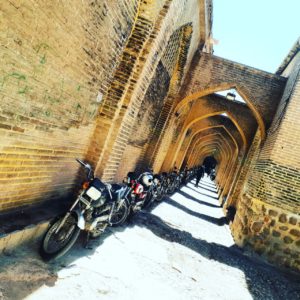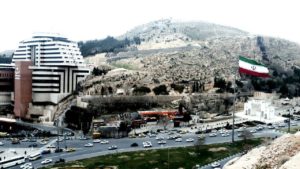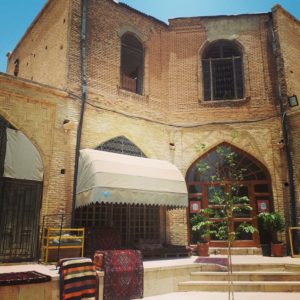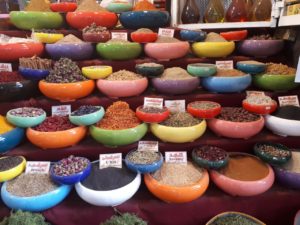Shiraz is hands down my favorite city in Iran. It seems to embody the whole vibe of the country in an astute way. Shiraz is the perfect mix of old and new, beauty and grunge, desert and oasis. With all the conveniences of a big city and all the charm of a village, Shiraz will feel like your Iranian home away from home.
Commonly cited as the city of poets, art, literature, and gardens, Shiraz has been a cultural hub of the region for thousands of years. Home to one of the most renowned medical universities in the Middle East, Shiraz has also recently become a destination for elective and cosmetic surgeries.
The “to do” list for first time travelers to Shiraz is not a short one. I would recommend spending at least 3 days in the vicinity of Shiraz. The first time I went to Shiraz we spent only 2 days and now in hindsight I know we missed out on a lot.

Alleyways of Vakil Bazaar, Shiraz
Climate
Located about 1,000 kilometers south of Tehran, Shiraz has a year round, temperate climate. Although summer days can be warm (35 degrees C as a ballpark) you can travel to Shiraz year round. Nestled on a fertile plain, surrounded by mountains, Shiraz was a strategic and comfortable place for its original settlers, some 4,000 years ago.
Where to stay
Having a comfortable place to stay can really make or break a traveler’s experience. Accommodation options in Shiraz are plentiful. From traditional guest houses and hostels through to five-star hotels. You can book Shiraz hotels easily online via 1stQuest.
Whenever I go to Shiraz I always stay at the Shiraz Grand Hotel. Now, don’t get me wrong, I do not usually frequent five-star hotels, however, the Shiraz Grand Hotel offers guests an unbeatable experience and value for money. The Hotel is on the outskirts of the city and is built into the mountain. With plush, newly renovated rooms with huge balconies that overlook the entire city, attentive staff, delicious buffet breakfast (complimentary for all guests) and an amazing gym, pool, sauna complex, I highly recommend a stay. Basically, the place is immaculate.
For other tips on where to stay check out: The 10 Best Shiraz Hotels for 2019 and Top 10 Cheap Hotels in Shiraz.

Views of the Qur’an Gate and the Shiraz Grand Hotel
Sightseeing
There is plenty of must-see places in Shiraz. Looking for a tour guide? You can book via 1stQuest. To help you out, I’ve prepared an example itinerary.
Day 1

Inside the Pink Mosque (Nasir e Molk Mosque), Shiraz
Probably the most popular thing for tourists is a visit to the Pink Mosque (Nasir al-Mulk Mosque) in downtown Shiraz. Due to it’s design, it is best visited before 11am when the light is at its best. A visit to this small mosque, famous for its stained-glass windows, is a great way to start your Shiraz experience! Beautifully understated from the street, be careful not to miss the entrance.
After the Pink Mosque you can meander your way over to the Shah-e-Cheragh Shine. In some ways, this shine is the complete opposite to the Pink Mosque. The Shrine is huge, ostentatious with gold, elaborate mirror work and marble. The Shah-e-Cheragh Shine is the resting place for the brothers of Imam Reza who took refuge in Shiraz during the prosecution of Shia Muslims in 900AD. The Shrine is free to visit and offers free guided tours in English. Here you can see thousands of visitors kissing the tombs and partaking in their daily prayers. Women are required to wear a chador in the Shrine – you can borrow one at the front gate no worries.
After a morning of mosques, I recommend you head to the Eram Garden in the afternoon. Eram Garden is a quintessential example of a Persian Garden. Thought to be built in the 11th Century, the Eram Garden has survived many a dynasty change. Nowadays it is owned and operated by the Iranian government. Over the centuries many visitors and guests to Shiraz have gifted trees to the owners of the garden and as such, Eram Garden can be likened to a botanical garden. Stroll though the pomegranate orchards, cool off by the fountain or enjoy a tea at the on-site cafe.
Day 2
No trip to Shiraz is complete without a visit to the ancient ruins of Persepolis and Pasargadae. Located about one hour north of Shiraz, it is well worth the trip. If you are traveling in summer, I think these ruins are best enjoyed in the morning, before the day gets too hot. On the way out of the city you will pass through the Qur’an Gate, home of a sacred copy of the Qur’an and thought to bless travelers on their way in and out of the city.

Pillars of Persepolis within the 125,000 square meter site.
On my first trip to Iran, I was lucky enough to meet some locals a hitchhike out the Persepolis on the back of a truck. Subsequent trips I have taken a private tour, which includes transfers from your accommodation and entrance fees. You can book a tour of Persepolis and Pasargadae via 1stQuest.
After returning to the city, I suggest you take an evening trip to the Tomb of Saadi or Hafezieh. Saadi and Hafez are beloved Iranian poets and are both laid to rest in the city of Shiraz. Locals regularly visit these tombs that are surrounded by beautiful gardens, to contemplate, soul, seek and read poetry. Although both places are interesting to see, there is no need to visit both unless you are a real poetry buff.
Day 3

Carpet shops in the Vakil Bazaar, Shiraz
It’s your last day in Shiraz and it’s time to go shopping! In my experience, Shiraz’s Vakil Bazaar has a good variety of Iranian handicrafts with better prices than the Grand Bazaar in Tehran. Throughout the bazaar’s winding alleyways, you will find caravansarais, mosques and traditional tea houses alongside the shops themselves. As well as finding favored Iranian souvenirs such as spices, teas, copperware and rugs, the Vakil Bazaar also offers special Shirazi handicrafts that include traditional fabrics, kilim rugs (loosely woven nomadic style rugs) and khatam goods (traditional Iranian inlaying technique using metals, wood and camel bone).
If you’re not into shopping, right next to the bazaar is the Vakil Bathhouse and the Karim Khan Citadel (also known as the Arg). The bathhouse is operating as a museum and has interesting explanations about traditional bathhouses and surprisingly (freakishly?) lifelike manikins. The citadel was built as a fortress in the 18th Century by the celebrated ruler, Karim Khan. It has been used as a prison but nowadays is a museum. Restoration is currently underway, but seeing prison graffiti and rubble in among the ornately restored rooms adds to the charm.
Although you could pack a bit more into three days, I suggest you don’t. Shirazi people are renowned within Iran to be extremely relaxed and a bit lazy. I recommend setting your clocks to Shiraz time and taking it easy! Here you can find things to do in Shiraz.

Tantilize your taste buds at the spice bazaar
Eating and drinking
Shiraz has its own unique style of Iranian food, so be adventurous in your menu choices. Try Salad Shirazi, a simple tomato based salad which is a yummy accompaniment to any meal. Another delicious morsel is Bahar Narange (orange blossom). It is a favourite Shirazi flavour that you must try in tea, jam and cordial. The irony of the nearby vineyards but the distinct lack of Shiraz wine is disappointing, but you get over it.
Some places to eat that I recommend trying are:
- Sufi Traditional Restaurantin Sattar Khan is a must for dinner one night. You can enjoy a salad bar and all different varieties of kebab while listening to a live band play traditional music. 10/10!
- Saray-E MehrTea House and Restaurant in the Vakil Bazaar is a good, cheap traditional joint for a quick lunch. Venture upstairs to the terrace.
- Haft- Khan Restaurant Complexis a multi-storey affair with several different restaurants inside. Really nice atmosphere but a bit pricey compared to other options. The basement is my pick for Iranian-Euro fusion as well as traditional foods.
Planning your trip
Because Iran is not well connected to international banking systems, there are no international ATMs, credit or debit card facilities available for tourists. To avoid carrying large amounts of cash, you can book your domestic flights, hotels, and transfers in advance, online via 1stQuest. 1stQuest also offers travelers an Iranian debit card, which can be charged with USD or EUR and converted to the local currency.
For a tailor-made itinerary where you choose your destinations, services, dates, and budgets, check out 1stQuest’s Untours. Bundle the services you want to save time and money!
